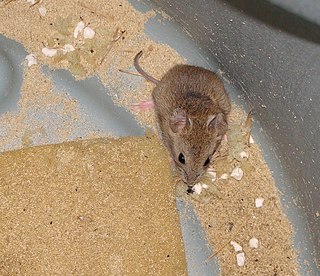
A genet is a member of the genus Genetta, which consists of 17 species of small African carnivorans. The common genet is the only genet present in Europe and occurs in the Iberian Peninsula, Italy and France.

The small vesper mouse is a rodent species from South America. It is found in Argentina, Bolivia, Brazil, Paraguay and Uruguay. It is one of the hosts of hantavirus, causing hantavirus pulmonary syndrome
The Bolivian vesper mouse is a species of rodent in the family Cricetidae. It is found in Argentina, Bolivia and perhaps Peru.
The crafty vesper mouse is a species of rodent in the family Cricetidae. It is found in Argentina and Paraguay.

Hummelinck's vesper mouse is a species of rodent in the family Cricetidae. It is found in Aruba, Brazil, Colombia, the Netherlands Antilles, and Venezuela.
The Andean vesper mouse is a species of rodent in the family Cricetidae. It is found in Argentina, Bolivia, Chile, and Peru.
The Peruvian vesper mouse is a species of rodent in the family Cricetidae. It is found only in Peru.
The caatinga vesper mouse is a rodent species in the family Cricetidae from South America. It is endemic to eastern Brazil, where it is found in open savanna (cerrado) and thorny scrub (caatinga) habitats. Its karyotype has 2n = 66 and FN = 68. It was formerly synonymized with C. callosus, but the latter has 2n = 50 and FN = 66. Karyologic analysis of C. expulsus has shown that the X chromosome is large and submetacentric while the Y chromosome is either acrocentric or submetacentric. Predators include the barn owl. Sexual dimorphism in shape and size occurs; the former is present mainly before the age of 20 days. Males are smaller before age 50 days and larger thereafter, which becomes less prominent after 200 days.
The Córdoba vesper mouse or Córdoba laucha is a South American rodent species of the family Cricetidae. It is endemic to the area of Córdoba Province, central Argentina, where it is found in the espinal.

The World's 25 Most Endangered Primates is a list of highly endangered primate species selected and published by the International Union for Conservation of Nature (IUCN) Species Survival Commission (SSC) Primate Specialist Group (PSG), the International Primatological Society (IPS), Global Wildlife Conservation (GWC), and Bristol Zoological Society (BZS). The IUCN/SSC PSG worked with Conservation International (CI) to start the list in 2000, but in 2002, during the 19th Congress of the International Primatological Society, primatologists reviewed and debated the list, resulting in the 2002–2004 revision and the endorsement of the IPS. The publication was a joint project between the three conservation organizations until the 2012–2014 list when BZS was added as a publisher. The 2018–2020 list was the first time Conservation International was not among the publishers, replaced instead by GWC. The list has been revised every two years following the biannual Congress of the IPS. Starting with the 2004–2006 report, the title changed to "Primates in Peril: The World's 25 Most Endangered Primates". That same year, the list began to provide information about each species, including their conservation status and the threats they face in the wild. The species text is written in collaboration with experts from the field, with 60 people contributing to the 2006–2008 report and 85 people contributing to the 2008–2010 report. The 2004–2006 and 2006–2008 reports were published in the IUCN/SSC PSG journal Primate Conservation,, since then they have been published as independent publications.

Urva is a genus comprising the Asian mongooses within the mongoose family Herpestidae. Species in the genus were formerly classified in the genus Herpestes, which is now thought to comprise exclusively African mongooses; phylogenetic evidence indicates that the Asian mongooses form a monophyletic group and had an Asian common ancestor. Urva forms a clade with Xenogale and Atilax, while Herpestes forms a clade with all other African mongoose species.






